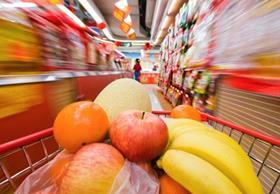
Supermarket sales have fallen slightly as shoppers gradually returned to old shopping habits, visiting stores more frequently but spending less per trip.
The latest take-home grocery figure from Kantar show that sales were down 1.6 per cent year on year in the 12 weeks to 13 June 2021.
The number of grocery trips remains lower than in pre-Covid times but since last year there has been a 13.1 per cent increase in the number of shopping visits made each month by British households.
As visits to store rise, there has been a corresponding fall in the average spend per trip, down 13.6 per cent, suggesting a return to more typical shopping patterns.
‘Shopping habits still not normal’
Fraser McKevitt, head of retail and consumer insight at Kantar, said:“While it’s encouraging to see shoppers returning to the habits of old, there is still a way to go before the market entirely returns to normal.
“That’s demonstrated by the fact that sales in the past 12 weeks were still £3.3 billion higher than in 2019 before the pandemic hit. Retailers will also be benefiting from sales of goods consumed on the go, such as picnics and lunches eaten at work, which are not captured in these numbers.”
Supermarket footfall in the four weeks to 13 June was down by five million trips compared with May. The re-opening of indoor hospitality in certain parts of the country took some spend away from the grocers and into the nation’s cafés and restaurants.
That said, the long-awaited arrival of summer saw retail sales peak, with shoppers celebrating a hot late May bank holiday and gearing up for the much-anticipated European football championships.
Online sales plateau
Online sales accounted for the same proportion of the market, at 13.4 per cent, in the four weeks to 13 June as they did in May. This plateau, and the fact that year-on-year sales were up by just 0.2 per cent, suggests the appetite for large online shops is approaching a new baseline.
Fraser McKevitt said:“A really interesting recent development in online shopping is the rapid growth of fast-track delivery services for smaller top-up shops. Tesco launched its Whoosh platform in May to compete against start-up disruptors including Gorillas, Getir and Weezy, which are moving into the market for smaller trips, with baskets under £25 currently worth £41 billion online and in store each year. It’s definitely a case of ‘watch this space’.”
The popularity of online sales during the past year has been one reason why Aldi and Lidl have been slow to make market share gains since the start of the pandemic. However, as shoppers revert to more typical habits, the two are finding success.
Discounter growth back on track
“Aldi was the fastest-growing retailer over the past 12 weeks, with sales up by 6.6 per cent,” said McKevitt. “Much of its gains came from older shoppers who, having been vaccinated, are now more confident about visiting stores.
“Aldi’s market share increased as a result by 0.7 percentage points to 8.2 per cent, matching its highest ever in March 2020. Lidl also enjoyed growth of 4.9 per cent and saw its share increase from 5.8 per cent to 6.1 per cent this period.
“Aldi and Lidl are of course also major players on a global level, and their solid domestic performance this month is backed up on an international scale by Kantar’s recently published BrandZ report, which measures the value of global brands. Aldi’s brand is now worth over $17.5 billion worldwide, while Lidl’s is valued at $11.7 billion.”
Promotions on the rise
Recent concerns about inflation in the wider economy have yet to materialise in the grocery market, where prices paid fell by 1.9 per cent year on year. That is partly because of an increase in the number of promotions currently on offer – this period 29.6 per cent of all grocery spending was done on some kind of deal, up from 26.4 per cent this time last year.
Sainsbury’s has had an eye on value with its ongoing price match campaign this year, and its market share has moved up by 0.3 percentage points to 15.2 per cent.
Tesco gained 0.2 percentage points of market share this period marking the fifth consecutive month it has increased, something which it hasn’t done since 2010.Britain’s largest retailer has also seen its global brand value grow in the past year by 27 per cent, according to Kantar’s BrandZ findings.
Asda too made gains, with footfall up by 29 per cent, more than any other Big Four retailer. Its market share also grew from 13.9 per cent in 2020 to 14.1 per cent.
Morrisons’ hot streak continues
Meanwhile, Morrisons’ market share remained at 10.1 per cent as it annualised against very strong growth in June last year.
McKevitt said: “Morrisons’ share price has jumped following private equity interest which came to light over the weekend.This follows nearly a year of solid retail performance for the grocer. In July last year it shrugged off several years of underperformance, and since then it has grown faster than the market each month until this one.”
Co-op’s market share fell back from 7.4 per cent to 6.3 per cent this period, with independent convenience store operators seeing a similar pattern as shoppers start to use them more on the go but rely on them less for take-home groceries.
Frozen food was very popular during last year’s lockdowns, an effect which is now slowing down for Iceland, with its share falling to 2.3 per cent of the market from 2.5 per cent 12 months ago.
Ocado’s growth slowed to 5.4 per cent as demand for online groceries stabilised, though it is worth noting that compared with two years ago it has seen a 50 per cent increase in sales.
Waitrose enjoyed growth of 3.3 per cent this period, meaning market share increased by 0.2 percentage points on a year ago to five per cent.



